Engagement is often referred to as a “vanity metric,” or a secondary metric—meaning it shouldn’t be your priority when creating Facebook Ads.
And it goes without saying that you goal when you advertise on Facebook should be to create ads that convert into leads, new registrations, or direct sales is the best indicator of your campaign’s success.
Engagement… attracting comments. Those aren’t even on the list.
Your priority should always be creating strong ad campaigns that achieve your specific goals and conversions.
But engagement can be the icing on the cake that helps increase your relevance score. So it’s still worth thinking about.
Some businesses insist that their ads were successful because they garnered higher-than-average engagement. Okay. But I always ask how those likes helped with their business goals.
Just because an ad gets engagement doesn’t mean it’s converting.
That being said, relevant engagement can be incredibly useful for your campaigns, actually contributing to your success in a number of ways.
Creating content that resonates with your target audience and gets comments and shares is a great sign. Even better, these ads are often more successful and help establish a desire for the product or service that you’re promoting.
In this case study, I’m going to show how I got 1,636 comments, 951 shares, and 61 replies to a single comment on one Facebook Ad, and show you how you can create hyper-relevant content that your audience will respond to beyond a simple click of the like button.
Why Avoiding Non-Relevant Engagement Is Essential.
When you’re thinking about comments and shares on your ads as potential indicators of success, you’ll want to remember that this is only true when the engagement is relevant to your business.
A marketing agency once came to me frustrated that their ads weren’t driving results. When looking at their campaigns, I quickly discovered why.
They had been running posts like “What’s your favorite ice cream flavor?!” and then promoting those high-engaging posts as ads.
The ads did get a lot of engagement. People love sharing their opinions, and who doesn’t love weighing in on their go-to ice cream favorite?
<Mine is s’mores for the record.>
That being said, this wasn’t relevant engagement. No one saw that post and thought “Finally! An agency that cares about ice cream flavors. I should hire them.”
The ads didn’t cultivate interest in or sell their products or services, or drive brand awareness. There were likes and some comments, but they did nothing for the brand’s goal of attracting new leads.
Always keep in mind the objective is to sell, not attract engagement.
So Does Engagement Ever Matter for Ads?
I expanded in detail on the ways in which engagement helps ads perform better, including referencing Facebook’s own documentation here.
In short… yes, it matters:
- Social proof can help attract the attention of additional viewers
- Engagement is a metric Facebook looks at to assess the relevance of your ad, which can increase your quality score. This increases placements and lowers CPC.
Finding the right balance of relevant, impactful engagement is key. Let’s take a look at how to do that.
Where Are My Manners? Let Me Introduce You to the Ad we’re talking about.
This is the ad that got 1,637 comments and hundreds of shares and replies:
 The ad uses relatable storytelling to promote a service to relevant audience members.
The ad uses relatable storytelling to promote a service to relevant audience members.
In the above image, note the 4.3k likes, hearts and laughs plus the 1.4k comments and 950 shares.
As people started sharing the post, it got more and more comments… bringing the total to 1,637.
For. An. Ad.
But it gets better…
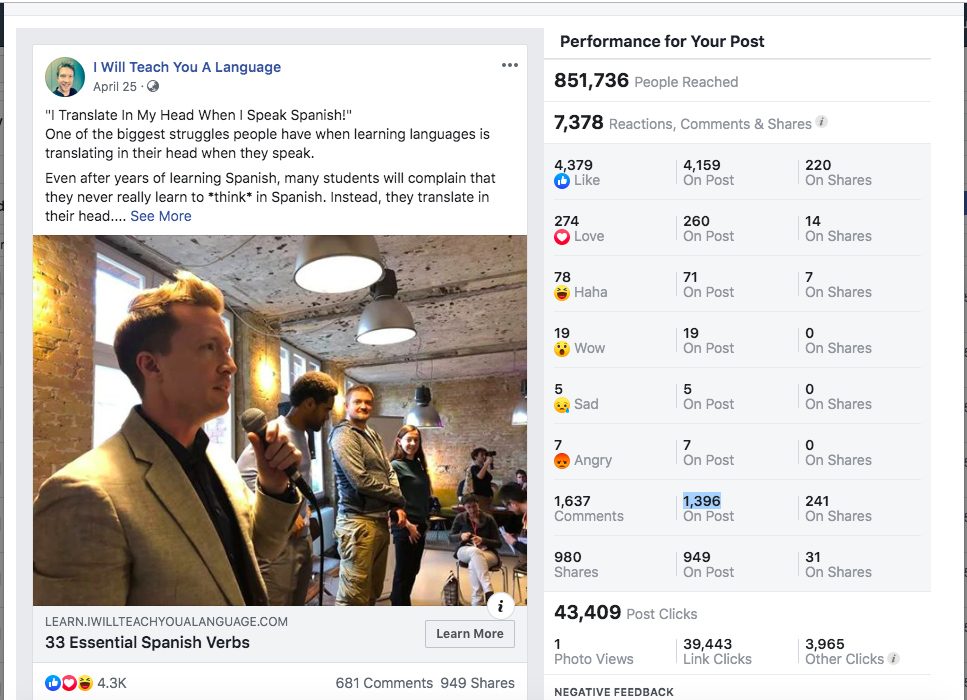
In addition to these basic metrics, when you dig further you can see that someone left a comment that got 61 replies. Another comment got 172 likes.
For. A. Comment. On. An. Ad.
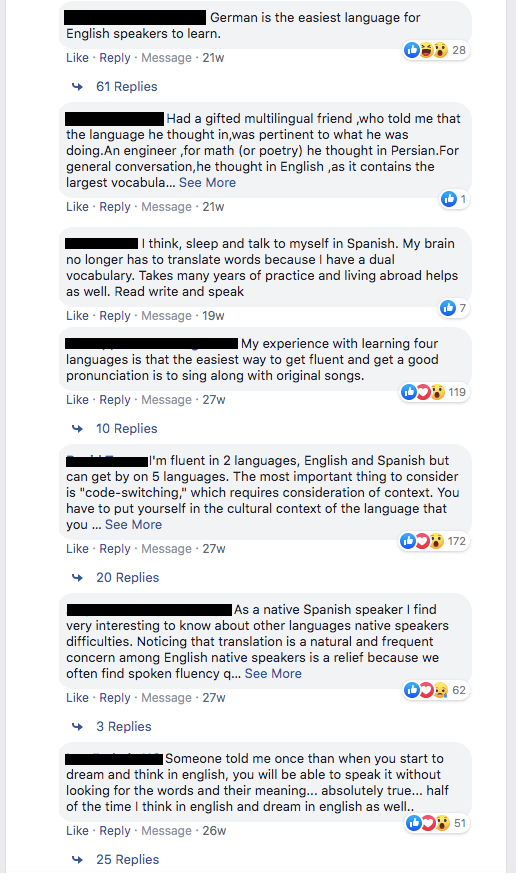
More interestingly, when expanding some of the nested comments, you can see a user left an initial comment and was still discussing the topic with other users 11 weeks later—yes, people were coming back to this add for 3 months. This is likely helped by the fact that Facebook automatically tags the user someone is replying to, keeping everyone engaged.
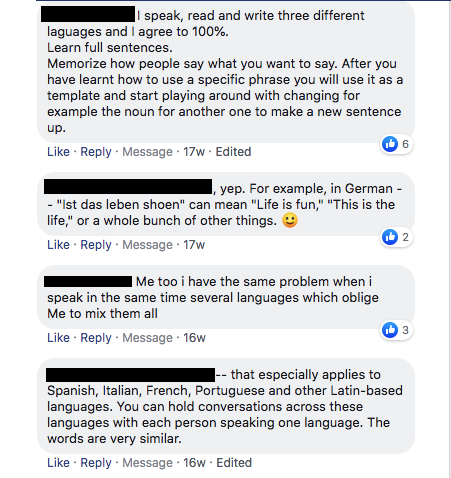 It’s fascinating. People were behaving as if the comments section were a discussion forum, and they stuck around for a significant period of time.
It’s fascinating. People were behaving as if the comments section were a discussion forum, and they stuck around for a significant period of time.
In part, thanks to the high engagement, this campaign was overwhelmingly successful, generating 13,988 leads at approximately £.42 per lead (that’s about 53¢ each). This ultimately resulted in 68 direct sales (as opposed to those that joined the email list and converted later). Each conversion was worth well over $100.

So, how did I do it?
How to Create an Ad That Yields Relevant Engagement and Drives Action.
Creating ad campaigns that drive relevant engagement and meaningful action is a worthy pursuit. Here are the five steps I follow to do it.
STEP 1: Language Is Abstract. Life Is Not.
It’s all about specific details.
It is easier to understand and engage with ads that you can visualize. We want to avoid ads that only rely on abstract language that isn’t meaningful or concrete.
“Good service” does not tell us why the Ritz Carlton’s service at $500 a night is better than the Holiday Inn’s at $60. The Holiday Inn can just as easily claim to have “good service.”
But when I read that a manager at Ritz-Carlton Bali had special eggs and milk flown from Singapore to Bali by his mother-in-law for a guest, I start taking notes.
Specificity is key, both in the claims that you’re making in your ad copy and the stories that you’re using to appeal to your audience.
Going back to the original ad, notice how I didn’t write, “Are you struggling to learn Spanish?”
Instead, I painted a clear image of what that struggle looks like. I focused on how some people confuse a common word such as “exit” in English with a faulty translation of success, expressed in Spanish as “éxito.” The actual right word is completely different: “salida.”
This is a relatable, frustrating struggle that someone learning Spanish might run into.
I then followed the ad with a real story of why thinking in English when speaking Spanish can cause problems for a new Spanish speaker.
The addition of a true story with concrete details around this ad’s topic was not a lucky guess. On the contrary, it was very purposeful. Adding actual customer experiences can engage readers more effectively. I painted a picture that’s memorable and resonates with the audience.
Which brings us to step number two…
STEP 2: Eliminate the Guesswork Around Benefits.
I often see business owners using abstract language to describe their offer, and I think:” I don’t understand what your product actually does.”
When an ad appears in people’s newsfeeds, they will scan it for a second or two. Maybe less. That’s it. Don’t assume they will work out the benefits of your offer, or visualize what you say. Instead, make your benefits crystal clear.
Let’s look at a couple of taglines to an ad for a cooking school as an example:
Option 1: “The cooking school for ambitious chefs who want to cook with confidence.”
Option 2: “90% of our past students have gone on to work at a Michelin star restaurant after graduating.”
Which of the above strap lines is more likely to get the right point across and attract the audience’s genuine attention?
There’s no guesswork of the benefit in the second line. No one should wonder how effective the program is, how it works, or what the point of cooking school is. Readers know they’ll get a high-quality education that almost guarantees an excellent career.
STEP 3: The “So What? Why Do I Care?” Method for Improving Benefits.
All customers have one question they automatically ask themselves without even realizing when assessing an ad campaign: What’s in it for me?
To improve ad copy and benefit points, I like to imagine someone who is passive aggressive and will loudly say when reading my copy: “And why should I care? So what?”
Here’s how that normally goes in my head while I’m mapping out my campaign:
Me: Join my webinar about cooking with coconut oil.
My Imaginary Friend: Why should I care?
Me: Coconut oil has more vitamin E.
Imaginary Friend: So what?
Me: Well, that’s good for the skin.
Imaginary Friend: So are donkey and monkey milk.
Me: Yes, but coconut oil makes your hair and skin shine, it reduces red spots, and, with time, you can afford to wear less make-up.
After a few “So what?” iterations, I typically manage to get to the bottom of why anyone should care about what the ad is actually saying. This is what you want to focus on in your ad campaigns. It often can yield story ideas and detailed benefits that generate relevant engagement and clicks, generated leads, and conversions.
Question every line as if there were an aggressive reader asking why should I care? Doing so should help you define exactly how to develop an ad that will drive useful engagement.
STEP 4: Angry Comments Are Your Best Friend.
Over the years, I’ve worked with many advertisers who spend a lot of time deleting negative comments that users left on their ads. This is usually a big mistake. They’re wasting a potentially powerful opportunity.
Instead of deleting negative comments, look at such comments as feedback that tells you (or your client) what to improve. And there’s an opportunity, or course, to address objections head on in the comments, which is also a good thing.
Relevant comments and engagement actually give insight about the conversations that go on inside prospects’ heads. You can use this to improve your campaigns moving forward.
Let me share an example.
The ad below promoted a workflow efficiency webinar for veterinarians.
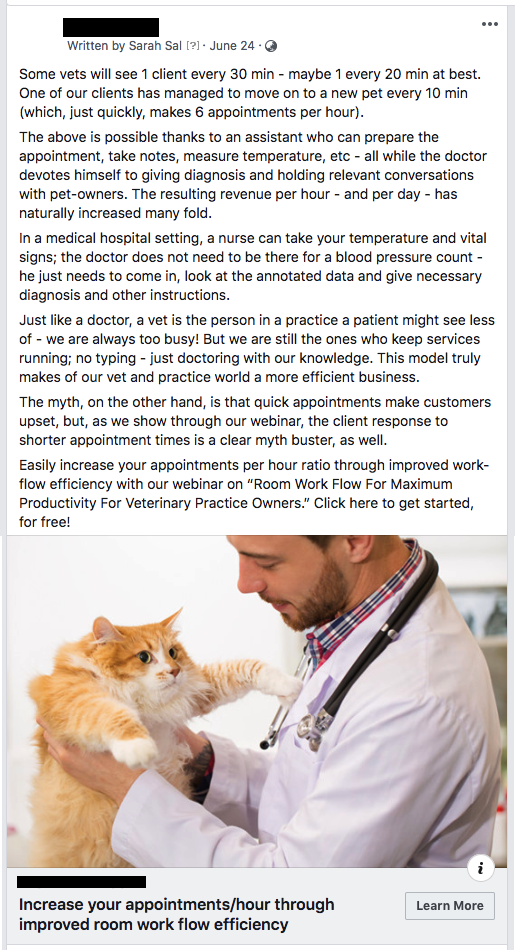 The ad got angry comments, like this one:
The ad got angry comments, like this one:
 If you’re paying attention, the comments are very useful. They tell you what misunderstandings and objections the viewer has with the ad, which you can use to improve the ad on the next round.
If you’re paying attention, the comments are very useful. They tell you what misunderstandings and objections the viewer has with the ad, which you can use to improve the ad on the next round.
The comments above mentioned how seeing more patients would lead to burnout and a lower quality of care. The next ad addressed these concerns:
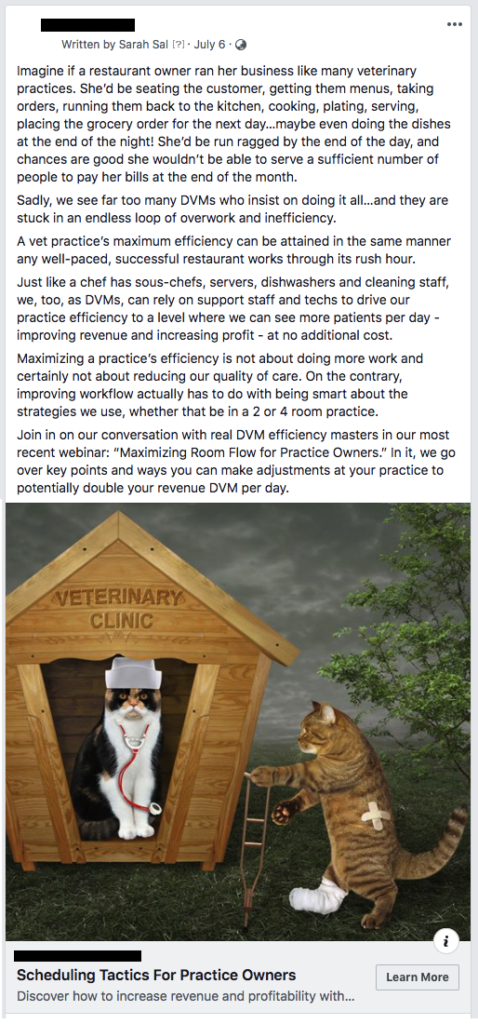 Even harsh criticism can offer a chance to improve. Instead of deleting what is hard to read, take negative remarks as feedback of your target audience’s deep insight for factual improvements.
Even harsh criticism can offer a chance to improve. Instead of deleting what is hard to read, take negative remarks as feedback of your target audience’s deep insight for factual improvements.
STEP 5: The Best Ads Don’t Look Like Ads.
A lot of ads on Facebook, on the other hand, focus on making big claims, instead of focusing on education and content.
Without education, you are writing an ad and asking the user to take your words at face value.
We’ve all seen those ads on Facebook with a “guru” and a picture of their Ferrari, telling fantastical stories about rising up from poverty into the ranks of wealth—and you can do the same if you purchase my book/program/mastermind! There are always an enormous number of negative comments on these campaigns. Even more people laugh or roll their eyes as they scroll on by.
This is why you want to teach, demonstrating your knowledge and value, instead of just promising that you offer value after a purchase.
Let’s look at an example on our language-learning ads.

Notice the following:
1) Someone shared a funny story about trying to practice a foreign language and it got 24 replies. When you tell a story, others feel a need to share their own.
2) The ad said practicing Spanish as soon as possible was more important than learning grammar. Someone disagreed with us, which is fine, but it started a conversation.
The commenters started a debate. Some agreed with him and others disagreed, which created 35 replies. People kept coming back to the ad as a result.
This is partially because ads using a storytelling approach don’t resemble ads. They’re interesting, engaging stories that people want to read and naturally react to.
Here’s another example from a campaign that I ran promoting a Copyhackers article:
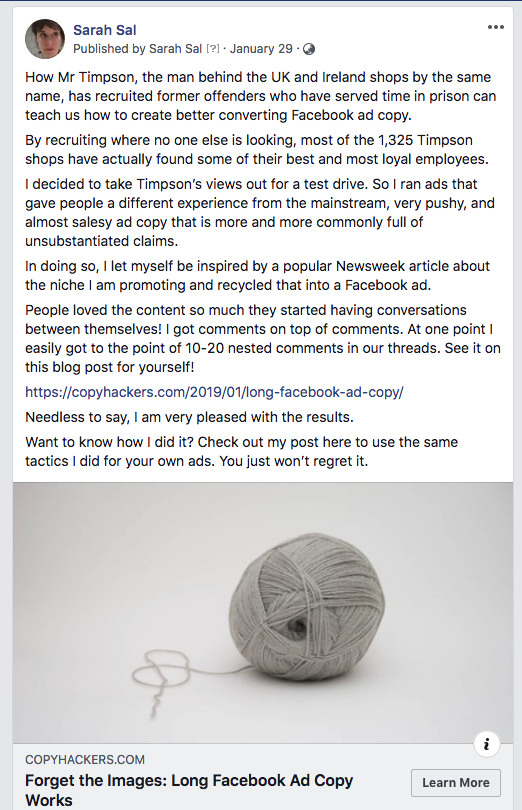 In the comments below, someone said they read the ad without even noticing it was an ad:
In the comments below, someone said they read the ad without even noticing it was an ad:
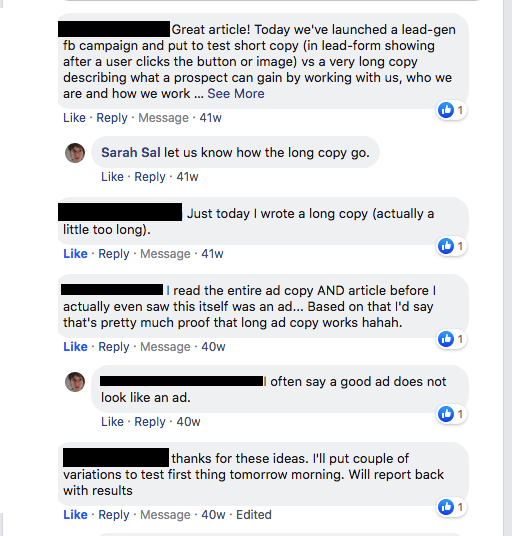
Instead of writing an “ad”, tell a story that your readers can learn from in the process. As people are inclined to share their own story, debate, or agree with the content, your ads start driving more efficient engagement from the audience who your content resonates with.
Why Does Any of This Matter?
Ad blockers are overwhelmingly popular. It’s estimated that around 30% of all internet users have them installed on their devices. We’re living in an environment that’s oversaturated with ads—especially when it comes to social media where ads show up every few posts and are always present in the sidebar.
Even if our technology doesn’t block ads out automatically, our brains are trained to ignore anything that looks like an ad.
By creating an ad that actually gives value, aha moments, and great content, we give users a reason to stop scrolling. And when they stop scrolling and they start engaging meaningfully, it’s a great chance to nurture a relationship that can lead to sales.
Sarah Sal is a Facebook Ads Specialist. She’s written on Facebook ad testing, strategy, and execution for AdEspresso, Agorapulse, Blitzmetrics, Copyhackers, ActiveCampaign, AdWeek, Jon Loomer’s Power Hitters Club and others. She’s even presented inside Perry Marshall’s iconic 80/20 Facebook ads course.

